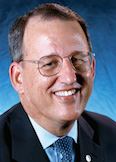Measuring Excellence
Posted on Nov. 15, 2004In his annual State of the University address in September, Chancellor James Moeser announced that, in consultation with the Board of Trustees and his administrative colleagues, he had developed a set of University priorities:
- Create the richest possible learning environment for undergraduate, graduate and professional students.
- Invest in centers of excellence in research and creativity.
- Strengthen faculty recruitment, retention and development.
- Enhance Carolina’s engagement with North Carolina and the world.
- Successfully complete campus development plan; begin Carolina North.
- Determine strategies to direct resources to UNC’s highest priorities.
- Define Carolina’s role as a leader.
These priorities are consistent with and further define
 an earlier agreed-upon set of “Measures of Excellence” also carefully and thoughtfully developed by the chancellor, his administrative team and the Board of Trustees. Taken together, these priorities and complementary measures of excellence can help Carolina’s faculty, students, staff, alumni and friends follow and contribute to the achievement of our shared vision of becoming our nation’s “Leading Public University.”
an earlier agreed-upon set of “Measures of Excellence” also carefully and thoughtfully developed by the chancellor, his administrative team and the Board of Trustees. Taken together, these priorities and complementary measures of excellence can help Carolina’s faculty, students, staff, alumni and friends follow and contribute to the achievement of our shared vision of becoming our nation’s “Leading Public University.”

Doug Dibbert ’70
Carolina’s progress toward becoming the nation ‘s leading public university is a journey that should never end. The progress we already have made reflects the sustained support of the people of North Carolina over many generations. We attract North Carolina’s and the nation’s brightest and most engaged students, who are inspired by a distinguished faculty genuinely committed to teaching, discovery and engagement.
There is an important distinction between “leading” and being “No.1.” As we know from sports, becoming No.1 is a temporary achievement — except, perhaps, if you’re the UNC women’s soccer team — and the only direction one can move is downward. “Leading” suggests that others are inspired by the example you set. A recent example would be the Carolina Covenant initiative, which has become a model for several institutions that share UNC’s commitment to providing access to intellectually gifted but financially challenged youngsters.
Of course, we are more accustomed to measures that convey bragging rights about wins, rankings and gifts — such as reflected in the accompanying chart. When he was chair of the faculty, Kenan Professor James L. Peacock III observed at a meeting of the Faculty Council that he had come to view Carolina as perhaps the nation’s most ” complete” university. He explained that while UNC doesn’t have Nobel Prize-winning professors, as does the University of California at Berkeley, or an endowment the size of Harvard, or a student body the size of several Big 10 institutions, taken together, he believed the quality of Carolina’s students and faculty, the beauty of the campus, UNC’s unique commitment to the people of the state, the breadth and quality of the intercollegiate athletics program, the presence of all five health affairs schools in close proximity to the academic affairs schools, our special commitment to undergraduate education while continuing to grow our research enterprise all of these and more, taken together, make for a “complete” university.
During this holiday season, as we reflect on a year gone by and recall Carolina’s many achievements and look forward to the challenges ahead, we can be comforted that our University — born in the 18th century, struggled but survived in the 19th century and earned national and international distinction in the 20th century — now in the 21st century continues the never-ending quest to become the nation’s leading public university.
Yours at Carolina,

Douglas S. Dibbert ’70
